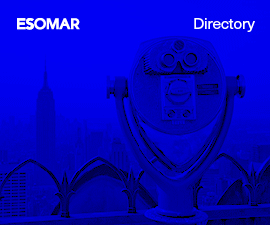- What we do
- Membership
- Knowledge
- Events
- Contact
Log in to your MyESOMAR account

You searched for: "" but we corrected it to "*"
Did you mean to search for ""? Click here to show those results.
The results has been filter on Tags containing Audience Measurement.
ANA has found 301 results for you, in
165 ms.
Currently showing results 199 to 207.
Didn’t find what you were looking for? Try the Advanced Search!
Research papers
 How to double your audience
How to double your audience
In Canada a combination of factors both stimulate and impede audience research. The complex Canadian broadcasting system and the competition among research suppliers create a situation in which innovative research solutions are frequently proposed...
Catalogue: ESORMAR/ARF Worldwide Electronic And Broadcast Audience Research 1994
Author: Barry Kiefl
 May 1, 1994
May 1, 1994
Citation
Kiefl, B. (1994a, May 01). How to double your audience. ANA - ESOMAR. Retrieved May 16, 2024, from
https://ana.esomar.org/documents/how-to-double-your-audience
Research papers
 Peoplemeters
Peoplemeters
The intent of this paper is to merely provide the perspective of one individual in the advertising industry. One rationale regarding the benefits derived from peoplemeters and the highlighting of a critical dimension of information that has been...
Catalogue: ESORMAR/ARF Worldwide Electronic And Broadcast Audience Research 1994
Author: Joseph C. Philport
 May 1, 1994
May 1, 1994
Citation
Philport, J. C. (1994a, May 01). Peoplemeters. ANA - ESOMAR. Retrieved May 16, 2024, from
https://ana.esomar.org/documents/peoplemeters
Research papers
 Towards harmonization of TV audience measurement
Towards harmonization of TV audience measurement
This paper sets out to summarise and to invite comment and criticism of the recently published 2nd edition of the EBU guidelines "Towards Harmonization of Television Audience Measurement Systems". It has been a collaborative venture involving...
Catalogue: ESORMAR/ARF Worldwide Electronic And Broadcast Audience Research 1994
Authors: Toby Syfret, Peter Menneer
 May 1, 1994
May 1, 1994
Citation
Syfret and Menneer (1994a, May 01). Towards harmonization of TV audience measurement. ANA - ESOMAR. Retrieved May 16, 2024, from
https://ana.esomar.org/documents/towards-harmonization-of-tv-audience-measurement
Research papers
 A model for forecasting the audience of television programs
A model for forecasting the audience of television programs
Our main objective has been to build a model which takes into account both the schedule of the different channels and the competition between them, forecasts reasonably well and with less error than extrapolation, is easy to use, can be used on...
Catalogue: ESORMAR/ARF Worldwide Electronic And Broadcast Audience Research 1994
Authors: Philippe Cattin, Remi Festa, Alain Le Diberder
 May 1, 1994
May 1, 1994
Citation
Cattin, Festa and Le Diberder (1994a, May 01). A model for forecasting the audience of television programs. ANA - ESOMAR. Retrieved May 16, 2024, from
https://ana.esomar.org/documents/a-model-for-forecasting-the-audience-of-television-programs
Research papers
 Measuring a difficult group
Measuring a difficult group
In any measurement system, there may be some groups that are more difficult to measure, or are perceived as more difficult to measure than others. In August of 1992, Nielsen started a program to address concerns about the accuracy of measurement of...
Catalogue: ESORMAR/ARF Worldwide Electronic And Broadcast Audience Research 1994
Author: Rachel Mueller-Lust
Company: Nielsen
 May 1, 1994
May 1, 1994
Citation
Mueller-Lust, R. (1994a, May 01). Measuring a difficult group. ANA - ESOMAR. Retrieved May 16, 2024, from
https://ana.esomar.org/documents/measuring-a-difficult-group
Research papers
 The television audience examined
The television audience examined
People use television in different ways and for different reasons. The variable use of television makes audience measurement challenging. The principles of measurement dictate that subjects which have a particular property should be included in a...
Catalogue: ESORMAR/ARF Worldwide Electronic And Broadcast Audience Research 1994
Author: Maura Clancey
 May 1, 1994
May 1, 1994
Citation
Clancey, M. (1994a, May 01). The television audience examined. ANA - ESOMAR. Retrieved May 16, 2024, from
https://ana.esomar.org/documents/the-television-audience-examined
Research papers
 TV audience measurement
TV audience measurement
The paper discusses the needs of the advertisers from media research in the dramatically changed TV environment many expect to happen already in the next few years. The key change of the TV medium will be fragmentation caused by a multi-channel...
Catalogue: ESORMAR/ARF Worldwide Electronic And Broadcast Audience Research 1994
Author: Thomas Neumann
 May 1, 1994
May 1, 1994
Citation
Neumann, T. (1994a, May 01). TV audience measurement. ANA - ESOMAR. Retrieved May 16, 2024, from
https://ana.esomar.org/documents/tv-audience-measurement
Research papers
 Phasing in a new rating methodology
Phasing in a new rating methodology
In February 1992 Nielsen Media Research announced a change in the existing People Meter methodology: specialists (called People Meter Representatives, or PMRs) were to be added to the field force to provide intensified training in the use of the...
Catalogue: ESORMAR/ARF Worldwide Electronic And Broadcast Audience Research 1994
Author: Barry Cook
Company: Nielsen
 May 1, 1994
May 1, 1994
Citation
Cook, B. (1994a, May 01). Phasing in a new rating methodology. ANA - ESOMAR. Retrieved May 16, 2024, from
https://ana.esomar.org/documents/phasing-in-a-new-rating-methodology
Research papers
 Programme environment and radio audience dynamics
Programme environment and radio audience dynamics
For many years, television has had instruments of audiometric measurement at its disposal. These measurements are instantaneous, precise and specific (programme by programme). Fixed panels (same people interviewed on an eight week basis) are able to...
Catalogue: ESORMAR/ARF Worldwide Electronic And Broadcast Audience Research 1994
Author: Abbas Bendali
 May 1, 1994
May 1, 1994
Citation
Bendali, A. (1994a, May 01). Programme environment and radio audience dynamics. ANA - ESOMAR. Retrieved May 16, 2024, from
https://ana.esomar.org/documents/programme-environment-and-radio-audience-dynamics







